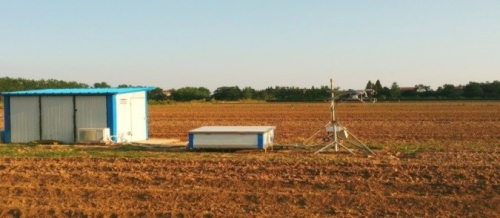Nitric oxide (NO) is a pollution gas that plays an important role in tropospheric chemistry. Agricultural ecosystem is one of the major sources of atmospheric NO due to the use of nitrogen fertilizers.
The eddy covariance method is one of the most effective way to measure the NO exchanges between agricultural ecosystem and atmosphere. This method provides spatially averaged fluxes at the field scale and produces temporally continuous data without disturbing the measured area.
"However, the application of this method in NO is extremely limited," said Dr. WANG Kai, the lead author of a new study published in Agricultural and Forest Meteorology, "because this method needs high-precision measurement of NO concentration at sampling frequency of 10 Hz, and very few gas analyzers could do it."
WANG, with Institute of Atmospheric Physics at Chinese Academy of Sciences and his collaborators from Aerodyne Research Inc. (ARI) have developed an eddy covariance system for measuring the turbulent flux of NO, by using a closed-path gas analyzer based on the quantum cascade laser (QCL) absorption spectroscopy technique.
This is the first attempt that a laser-based analyzer was used in the measurements of turbulent flux of NO.

Photo of the experimental field and the eddy covariance measuring system. (Photo by WANG Kai)
To evaluate the performance of this system as well as the QCL gas analyzer, the team conducted field experiments on a cropland in the suburb of Yueyang city in Hunan Province. This cropland is a typical agricultural ecosystem in subtropical China, with extensive use of nitrogen fertilizers during the growing season.
During the two-month measuring period, the eddy covariance system showed good stability and high precision that is sufficient enough to detect the turbulent flux of NO even during the low emission period without fertilizer effect.
"The field experiments show that the eddy covariance system based on the QCL gas analyzer has the advantages of stable performance, high precision and fast response, and feasible instrumental maintenance." Said WANG. "Our study provides a new option for the long-term field measurements of NO turbulent fluxes between terrestrial ecosystem and atmosphere."
The researchers are planning to work on the correction of NO loss due to chemical reactions with ozone below the sensor height. According to the team, only by taking this component into account, one can get the estimation of NO emissions from the soil to the atmosphere.
Citation:Kai Wang, Dong Wang, Xunhua Zheng*, David D. Nelson, 2020. Applicability of a closed-path quantum cascade laser spectrometer for eddy covariance (EC) flux measurements of nitric oxide (NO) over a cropland during a low emission period. Agricultural and Forest Meteorology 282–283: 107855. https://doi.org/10.1016/j.agrformet.2019.107855
Media contact: Ms. LIN Zheng, jennylin@mail.iap.ac.cn
